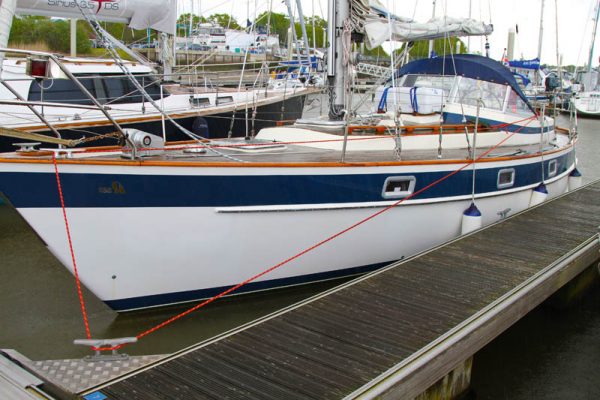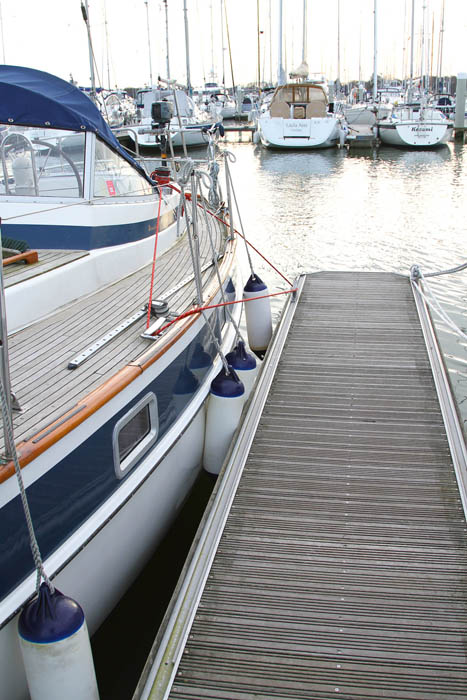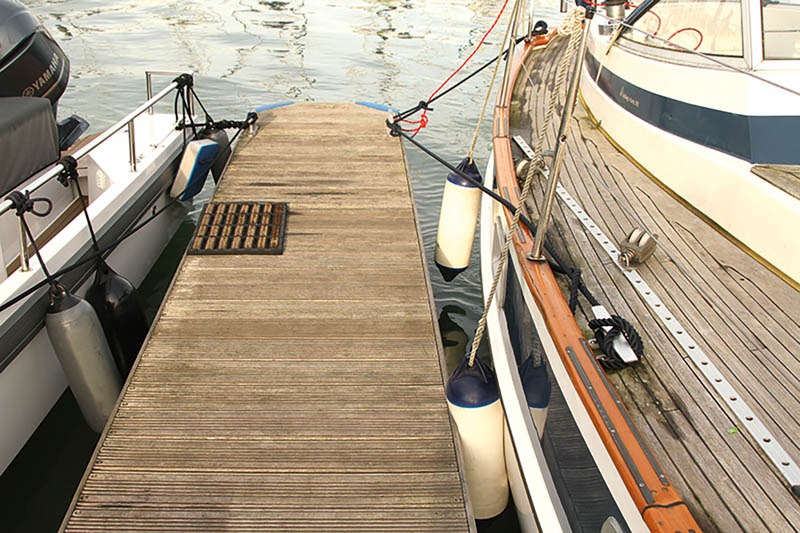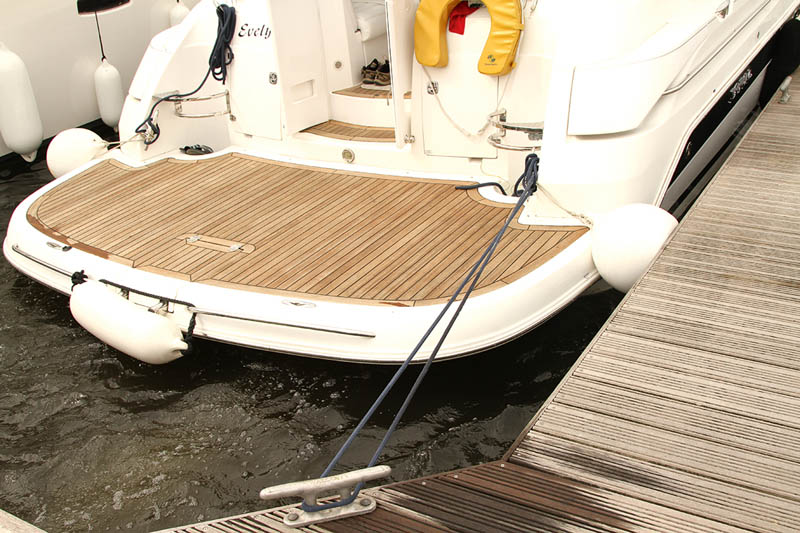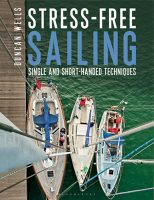Duncan Wells describes a number of easy methods to leave the dock with both sail and power vessels
Getting a boat on and off the dock – coming alongside and casting off – can be stressful and, done badly, the experience can ruin a perfectly good weekend. Boating is fun and the fun is improved when skipper and crew are confident doing manoeuvres. The way to confidence is to have some tried and tested techniques up your sleeve and to practise them.
The key element in the close quarters manoeuvring – coming alongside or casting off – is the tide, or current. When coming alongside: always moor into the tide or current. That way you can use the tide as a brake. When I say ‘moor into the tide’ I mean point the bit of the boat that you want at the uptide end of the slot or berth into the tide. So, if you are going to moor stern to, then it is your stern you will point into the tide or current. If bows to, then it’s the bows that you point into the tide.
If you moor with the tide or current, you will have no way of stopping without using your engine. But the minute you put the engine into neutral the tide will take over and run you through your berth or, if alongside, into the boat ahead.
Coming alongside under control
Travelling at 2 knots through the water against a 1 knot tide, you are going 1 knot over the ground. You are in control and can use the tide as a brake.
Travelling at 2 knots through the water with a 1 knot tide behind, you are going at 3 knots over the ground and are out of control and cannot use the tide as a brake.
Getting off the dock
The same goes for getting off the dock. For me, I back out and so I like to do this when the tide is pushing me out of my berth. That way I have control. Of course it is possible to back out of your berth with the tide pushing you into it but you do need to give yourself plenty of clearance before going ahead to exit into the fairway.
The key is to be aware of what the tide will do to your boat. The wind, too. We should make ourselves aware of what the tide will be doing to us long before we arrive at the boat. And at our home berth we will have worked out exactly what the tide does at any given hour.
We will only really see what the wind is doing when we walk along the dock to our berth. We will have a forecast for the day, of course, but for the specifics of how the wind will affect us when we come to leave the berth, the wind indicators on our own boat and the boats around us will give us a precise picture of how we need to approach matters.
How to cast off singlehanded
Let’s look at a couple of ways of getting off the dock singlehanded. When we have crew these jobs can be shared, of course.
If we stand on the dock and let go of the string the boat will drift off with the tide and the wind. So we need techniques that we can handle on board from the cockpit or helm.
1. Use a slipped stern line
Say we are stern to in our berth: a simple technique that we can use is a slipped
stern line.
1. Tie a bowline in the end of a line and place this over a cockpit winch (yacht), or on
a stern cleat (motorboat).
2. Take the running end to the shore and round a cleat at the stern.
3. Bring the running end back on board and secure on a cockpit winch (yacht), or OXO onto the stern cleat.
4. Click the engine into ahead.
5. Adjust the lie of the boat along the dock with the rudder.
6. Remove mooring warps.
7. Engine into neutral.
8. Release line from cockpit winch (yacht) or undo OXO (motorboat) and haul in on the inboard end of the line.
9. Engine into ahead and depart.
2. Slipped stern bridle
This is very similar to the slipped stern line method described above, except it goes from the cockpit winch/stern cleat to a midship cleat, around this and then to the shore cleat by the stern and then back up to the cockpit winch or OXO’d onto the cleat. The advantage of this over the slipped stern line method is that you are now held amidships, which could be an advantage if there was a reasonable breeze blowing you off the dock.
3. Slipped midship line
This works well for any boat. We tether the boat amidships with a slipped line from the cockpit winch/stern cleat to the midship cleat, down to a cleat on the dock, back up to the midship cleat and then to the cockpit winch or stern cleat. Keeping the two parts of the line apart from each other is key here when hauling in so there is as little friction as possible.
You don’t even need to click the engine into gear. Motorboats being flat-sided lie very nicely to a midship line.
Yachts will yaw (oscillate) a bit, but if the line is tight and the boat is well fendered then the degree of lateral movement is reduced.
4. Bow bridle
I always used to set up a bow bridle on my sailing boat. A line from a strong point in the cockpit goes inside the shrouds to the bow cleat, down to a cleat on shore at the bow and then back up amidships to be secured on a cockpit winch. For motor boats we run this from a stern cleat and back to the stern cleat. Click the engine into astern and the boat will hold against this while you step ashore and remove the mooring warps. Don’t forget the shore power!
On departure, either click the engine into neutral, take the outboard end of the line off the cockpit winch or the stern cleat and haul in on the inboard end or, as I do on my sailing boat, just leave her in gear astern as you release and retrieve the bow bridle.

The lines are not long enough so are joined together with a couple of bowlines. Note that the join is on the inboard end
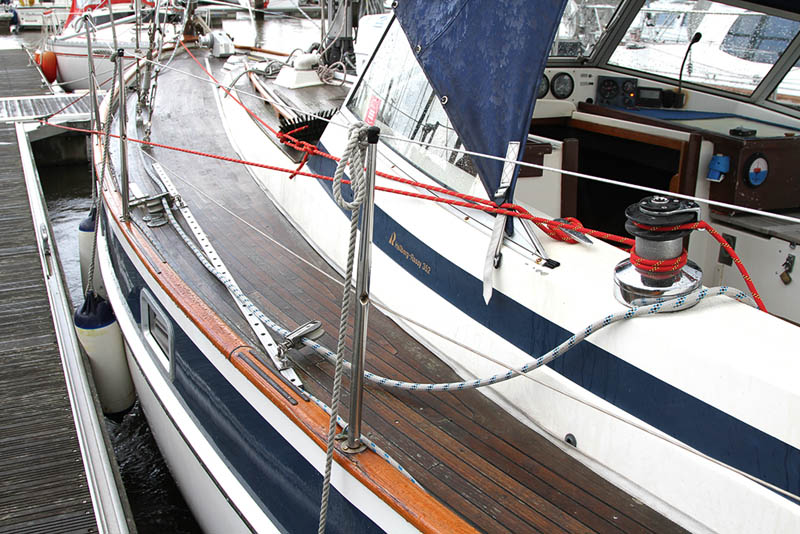
From a strong point in the cockpit to the bow to the shore, back up amidships and secured on a cockpit winch. Release the line on the winch and haul in on the inboard… and you’re off
A mooring arrangement for a singlehanded departure
Recently I have started mooring my boat with four lines.
Many of us will have heard the ‘one line, one job’ mantra, when it comes to mooring but I have pretty much ignored this for all my sailing life and moored with two lines: The bow line with half an OXO on the shore cleat does for the back spring, which we OXO on the midship cleat and the stern line with half an OXO on the shore cleat does for the head spring, brought up amidships.
It was a friend who embarrassed me into doing it properly – the purist’s way.
So I tried to find some advantage in it: and I have. Because by mooring this way you can set up for a singlehanded departure with great ease.
You see as long as I have bowlined ends round the cleats on shore, and as long as I keep the headspring bowline under the stern line, I can simply add a tripping line to the headspring bowline, then click the engine into ahead and now the boat is holding alongside to this.
I then remove the other lines, bow, back spring and stern from on board.
Then with a little astern to get the boat moving backwards and then into neutral, when the cockpit comes alongside the stern most cleat with the head spring bowline on it, I just lift it off with my tripping line, then astern and away we go.

Red tripping line attached to the headspring. Note the other blue line, the stern line is above the headspring, as it needs to be removed before the headspring

If slipping singlehanded, once you’re alongside you can use a tripping line to lift off the headspring
How to cast off a twin-engined motorboat
Motorboats generally have much more powerful engines than sailing boats. When we’re skippering a twin-engined boat, it is best to hold her alongside driving against a spring or bridle under one engine only. If we use the inner engine all will be well.
With some motorboats when using the outer engine only, which turns the boat towards the dock, there is a tendency to ‘climb the dock’.
If you have stern drives then you can control how the boat lies alongside the dock by having one in astern and the other in ahead and angling the drives, so you can either have a lot of tension in the spring or bridle to which you are lying, or just a little.
About the author
 Duncan Wells is an RYA instructor, principal of westviewsailing.co.uk, author of Stress-Free Sailing and Stress-Free Motorboating and the creator of MOBLifesavers.com
Duncan Wells is an RYA instructor, principal of westviewsailing.co.uk, author of Stress-Free Sailing and Stress-Free Motorboating and the creator of MOBLifesavers.com
First published in PBO April 2018: Subscribe now and save at least 30% on newsstand prices




